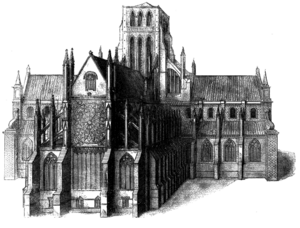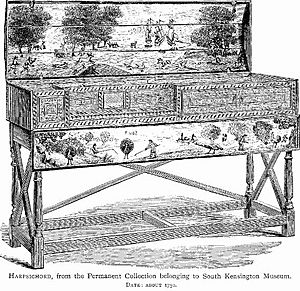Martin Peerson facts for kids
Quick facts for kids
Martin Peerson
(or Pearson, Pierson) |
|
|---|---|
| Born | Between 1571 and 1573 probably March, Cambridgeshire, England |
| Died | 1650 or 1651 (aged 77–80); buried 16 January 1651 London, England |
| Genres | Classical music |
| Occupation(s) | Composer, organist and virginalist |
| Years active | Beginning of the 17th century |
Martin Peerson was an English composer, organist, and virginalist. A virginal is a type of small harpsichord. He lived between 1571 and 1651. Even though he had Roman Catholic beliefs, which were not allowed by the official Church of England at the time, people highly respected his musical talent. He worked at important places like St Paul's Cathedral and possibly Westminster Abbey. He wrote many different kinds of music. This included religious songs, non-religious songs, and pieces for keyboard instruments.
Martin Peerson's Life and Musical Journey
Martin Peerson was likely born in a town called March, Cambridgeshire, England. This was probably between the years 1571 and 1573. His parents were Thomas and Margaret Peerson. Records suggest his father might have passed away early. His mother then remarried in 1573.

In the 1580s, Martin was a choirboy at St Paul's Cathedral in London. He learned music there from the organist, Thomas Mulliner. Later, a famous poet named Fulke Greville supported him. This support helped Martin with his music career.
In 1604, one of Peerson's songs was performed for the King and Queen. This happened during a special show by the writer Ben Jonson. By 1609, Peerson was living in London and writing many pieces for the virginals. The virginal was his main instrument. Around this time, he was found to have different religious beliefs than the official Church of England. This was against the law back then.
Peerson's Studies and Later Roles
Peerson then went to the University of Oxford to study music. To do this, he had to agree to the official Protestantism religion. In 1613, he earned a music degree. He also became the Master of the Boys at Canterbury Cathedral. This meant he was in charge of the choirboys there.
From 1623 to 1630, he might have worked at Westminster Abbey. Between 1624 and 1625, he returned to St. Paul's Cathedral. There, he became the Master of the Choristers. This was a very important job, as he trained the young singers. Even when the English Civil War started in 1642 and church services stopped, he kept his title. He also received special money to support him. Martin Peerson was buried on January 16, 1651, at St. Paul's. He likely died in late 1650 or early 1651.
Despite his Roman Catholic beliefs, Peerson was highly respected. His important positions in the Church of England show how much people valued his musical skills.
Martin Peerson's Music
Martin Peerson had powerful supporters. This allowed him to print and publish a lot of his music. However, not much of it has survived until today. We only have four of his keyboard pieces. These are "Alman," "The Fall of the Leafe," "Piper's Paven," and "The Primrose." They are found in a very important old music book called the Fitzwilliam Virginal Book. This book has nearly 300 pieces from the late 1500s and early 1600s.
Peerson also put music to some poems written by William Leighton. These poems were published in a collection called The Teares and Lamentatacions of a Sorrowfull Soule in 1614. Two years later, he published Tristiae Remedium. This book used mostly psalm texts in English.
In 1620, Peerson's collection Private Musicke was published. It included non-religious songs for one or two voices. These songs were meant to be played with instruments like viols or virginals. He also contributed tunes to a book of psalms by Thomas Ravenscroft in 1621. In 1630, he published Motets or Grave Chamber Musique. These songs had English words and used a new musical style called figured bass. This collection also has two beautiful sad songs.
Peerson's music often showed strong ties to older Renaissance music styles. But he also used newer ways of composing. For example, he sometimes used chromaticism. This means using notes that are outside the main scale, which can create a very expressive sound. He was also good at "word painting." This is when the music tries to show the meaning of the words.
Some of his best music is in his 15 Latin motets. These were probably written around 1600. Only one copy of these motets exists, and one part of it was missing. A professor named Richard Rastall spent 12 years putting the missing part back together. Now, all of Peerson's Latin motets have been published. There is also a recording of them called Peerson: Latin Motets.


